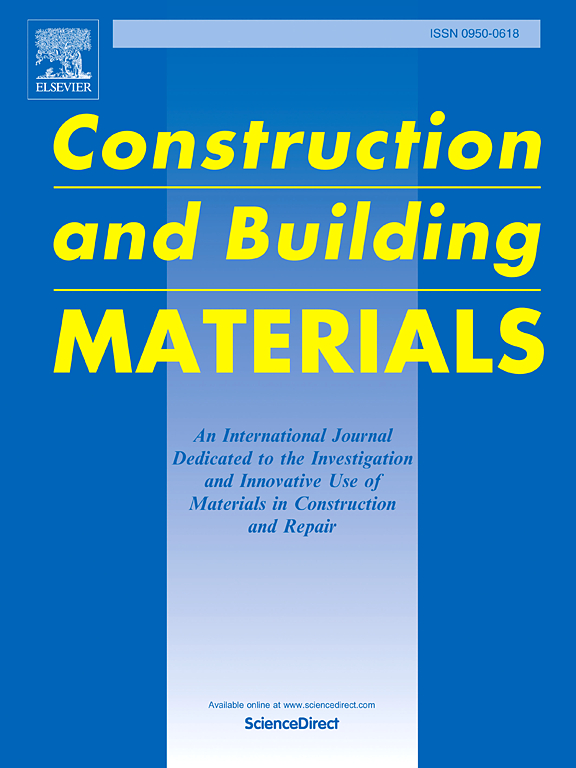Lifetime damage evolution of concrete joints in CRTS II slab track using mesoscale modelling under combined thermal action and vehicle load
IF 7.4
1区 工程技术
Q1 CONSTRUCTION & BUILDING TECHNOLOGY
引用次数: 0
Abstract
The condition of the concrete joints in the slab track of the China Railway Track System (CRTS) II is crucial to the safe operation of high-speed railways. In order to predict the lifetime damage evolution of the concrete joint under the combined thermal action and vehicle load, a new coupled thermal-mechanical numerical model at the mesoscale is developed. First, the meteorology and heat transfer principles are adopted to simulate the temperature distribution of the slab track. The heterogeneous characteristics of the joint concrete are modelled by the concrete plastic constitutive model and random aggregate algorithm at the mesoscale. Then, the plastic strain state of the concrete joint can be obtained by the coupled thermal-mechanical analysis. The proposed numerical model can provide reliable predictions for the temperature distribution, and the concrete modelling at the mesoscale can accurately reflect the corresponding mechanical properties, which is confirmed by the relevant field measurements. Finally, the lifetime of the concrete joint is estimated by the accumulative residual plastic strain damage model associated with the plastic strain state under the combined thermal action and vehicle load. From the obtained results for the numerical example, the most vulnerable zone of the concrete joint is located at the top part of the T-shape concrete joint, and the climate change can significantly reduce the lifetime of the concrete joints in the slab track.
基于中尺度模型的CRTS II型平板轨道混凝土节点在热作用和车辆荷载联合作用下的寿命损伤演化
中铁二期平板轨道混凝土节点的状态对高速铁路的安全运行至关重要。为了预测混凝土节点在热荷载和车辆荷载共同作用下的寿命损伤演化,建立了一种新的中尺度热力-力学耦合数值模型。首先,采用气象学和换热学原理对板坯轨道的温度分布进行了模拟。采用混凝土塑性本构模型和随机集料算法对节理混凝土的非均质特性进行了中尺度模拟。然后,通过热-力耦合分析得到混凝土节点的塑性应变状态。所建立的数值模型能够提供可靠的温度分布预测,中尺度的混凝土模型能够准确反映相应的力学特性,相关的现场实测证实了这一点。最后,利用结合热作用和车辆荷载作用下的塑性应变状态的累积残余塑性应变损伤模型估算混凝土节点的寿命。从数值算例得到的结果来看,t形混凝土节点的最脆弱区域位于节点顶部,气候变化会显著降低板式轨道混凝土节点的寿命。
本文章由计算机程序翻译,如有差异,请以英文原文为准。
求助全文
约1分钟内获得全文
求助全文
来源期刊

Construction and Building Materials
工程技术-材料科学:综合
CiteScore
13.80
自引率
21.60%
发文量
3632
审稿时长
82 days
期刊介绍:
Construction and Building Materials offers an international platform for sharing innovative and original research and development in the realm of construction and building materials, along with their practical applications in new projects and repair practices. The journal publishes a diverse array of pioneering research and application papers, detailing laboratory investigations and, to a limited extent, numerical analyses or reports on full-scale projects. Multi-part papers are discouraged.
Additionally, Construction and Building Materials features comprehensive case studies and insightful review articles that contribute to new insights in the field. Our focus is on papers related to construction materials, excluding those on structural engineering, geotechnics, and unbound highway layers. Covered materials and technologies encompass cement, concrete reinforcement, bricks and mortars, additives, corrosion technology, ceramics, timber, steel, polymers, glass fibers, recycled materials, bamboo, rammed earth, non-conventional building materials, bituminous materials, and applications in railway materials.
 求助内容:
求助内容: 应助结果提醒方式:
应助结果提醒方式:


